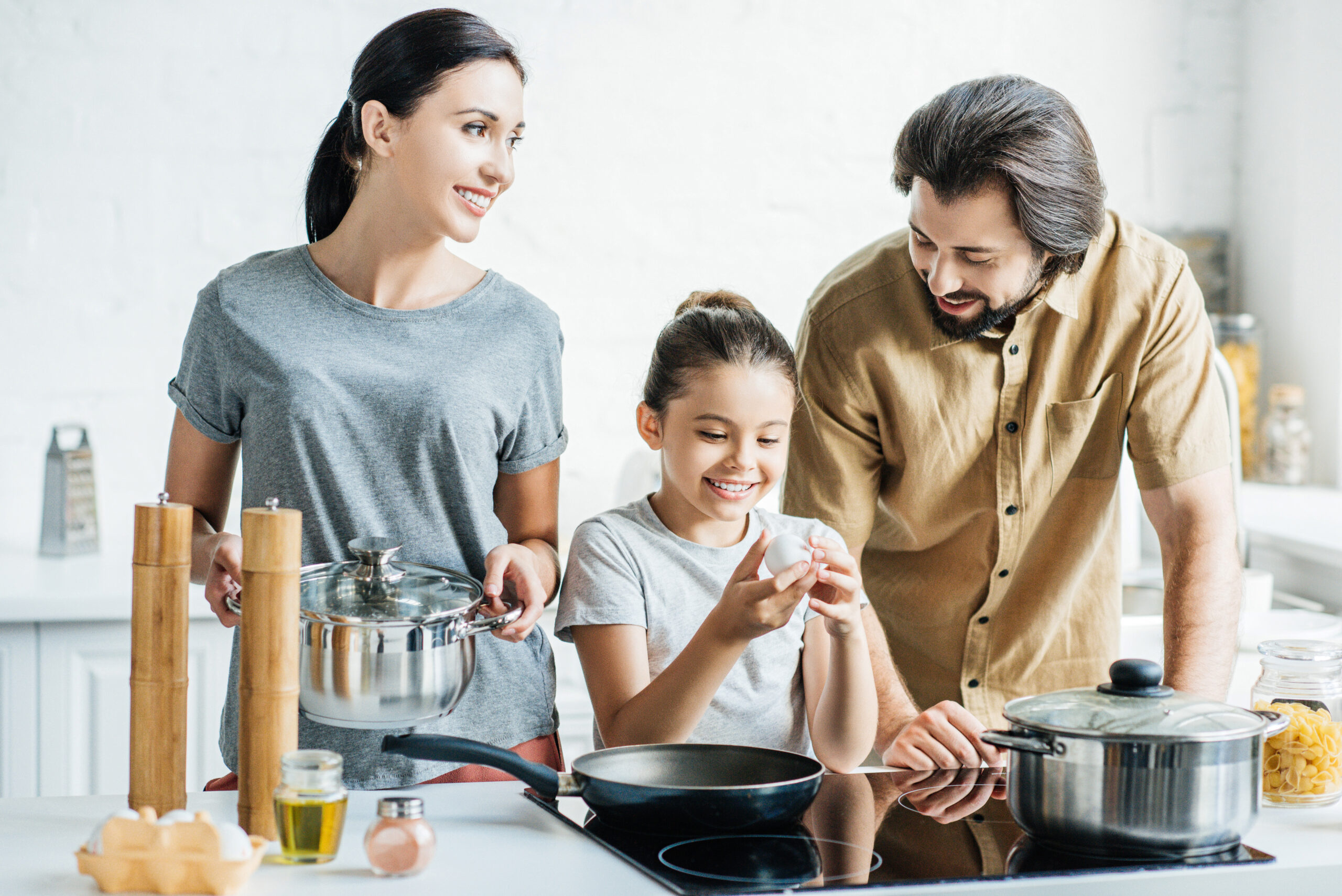Well congratulations on buying your first Calphalon Cookware. You can find answers to all your questions in this article about Calphalon Cookware Care. This article provides a guide to caring for your Calphalon cookware, from understanding what materials are used to make the pots and pans, to finding out if they are safe to use with metal utensils. You will learn how to clean, season, and store your Calphalon pieces, as well as find out about the warranty and potential safety concerns associated with the brand. This article will make sure that you can care for your cookware with confidence, whether you’re a seasoned Calphalon user or a new user! 🙂
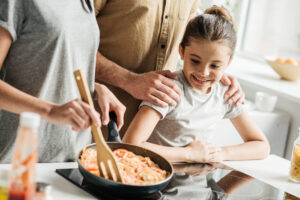
This image is property of images.pexels.com.
What is Calphalon cookware?
Calphalon cookware is a brand that has innovative kitchen products. Calphalon has a history that goes back to the 1960s and has established itself as a leader in cookware. The brand uses advanced technologies and premium materials to create cookware that is durable and functional for both home cooks and professional chefs.
Explanation of the Calphalon Cookware brand and its history
Calphalon was founded in Ohio in the 1960s and initially focused on creating aluminum cookware. The brand gained a reputation for producing high-quality cookware that delivers exceptional performance and is durable.
Calphalon’s hard-anodized aluminum cookware became a favorite among professional chefs and cooking enthusiasts. This innovative material has superior heat distribution and resistance to staining.
Calphalon continued to innovate and introduce new cookware, including non-stick, cast iron, and stainless steel, to cater to the different needs and preferences of home cooks. The brand is committed to continually improving its products and staying at the forefront of cookware technology.
Overview of the types of cookware offered by Calphalon
Calphalon offers a wide range of cookware options to suit different cooking styles and preferences. Here are some of the main types of cookware offered by the brand:
- Hard-Anodized Aluminum: This is Calphalon’s most popular and iconic line of cookware. It features a durable, non-porous surface that is resistant to scratching and easy to clean. Hard-anodized aluminum cookware provides excellent heat distribution and retention, making it ideal for a variety of cooking techniques.
- Stainless Steel: Calphalon’s stainless steel cookware offers a classic and timeless look. It features a heavy-gauge aluminum core surrounded by stainless steel, providing excellent heat conductivity and even cooking. Stainless steel cookware is versatile and suitable for various cooking methods, including searing, browning, and deglazing.
- Non-Stick: Calphalon’s non-stick cookware is perfect for those who prefer low-fat cooking and easy cleanup. It features a durable non-stick coating that allows food to slide off effortlessly and requires minimal oil or butter. Non-stick cookware is suitable for delicate foods like eggs, pancakes, and fish.
- Enameled Cast Iron: Calphalon’s enameled cast iron cookware combines the superior heat retention and even heat distribution of cast iron with the convenience of an enamel coating. This type of cookware is perfect for slow cooking, braising, and baking, as it can withstand high temperatures and retain heat for extended periods.
- Copper: Calphalon’s copper cookware offers excellent heat responsiveness and control. It features a copper exterior for fast and precise heating, while the interior is lined with stainless steel for easy maintenance and durability. Copper cookware is prized by professional chefs for its exceptional performance and beautiful appearance.
- Ceramic: Calphalon’s ceramic cookware features a ceramic non-stick coating that is free of PTFE and PFOA. It provides excellent food release and is scratch-resistant. Ceramic cookware is suitable for low to medium-heat cooking and is an excellent choice for health-conscious individuals.
Overall, Calphalon offers a comprehensive range of cookware options to suit the needs of every home cook, whether you’re a seasoned chef or just starting in the kitchen. The brand’s commitment to quality and innovation ensures that you can trust Calphalon cookware to deliver exceptional performance and durability.
Is Calphalon cookware safe to use?
Yes, Calphalon cookware is safe to use when used according to the manufacturer’s instructions. The brand is committed to producing high-quality, safe, and reliable cookware that meets rigorous safety standards.
Discussion on the safety features of Calphalon cookware
Calphalon cookware is designed with safety in mind. The brand incorporates various safety features to ensure that their products can be used with peace of mind:
- Non-Toxic Materials: Calphalon uses non-toxic materials in the construction of its cookware. For example, its non-stick coatings are free of PFOA, a potentially harmful chemical commonly used in non-stick coatings. By eliminating PFOA, Calphalon ensures that its non-stick cookware is safe for everyday use.
- Heat-Resistant Handles: Calphalon cookware is equipped with heat-resistant handles that remain cool to the touch during stovetop cooking. This feature helps prevent burns and accidents while handling hot cookware.
- Tight-Fitting Lids: Calphalon’s cookware lids are designed to fit snugly, locking in moisture and flavor during cooking. This feature promotes even heat distribution and reduces the risk of hot spots and steam-related accidents.
- Durable Construction: The high-quality materials and construction techniques used by Calphalon ensure that its cookware is resistant to warping, cracking, and other structural issues. This durability helps prevent accidents and promotes safe cooking.
Information on any potential health risks associated with Calphalon cookware
When used properly, Calphalon cookware does not pose any significant health risks. However, it’s important to follow the manufacturer’s instructions and use the cookware within its recommended temperature limits to avoid potential issues.
Excessive heat can cause non-stick coatings to degrade and release fumes, which may be irritating to some individuals. To prevent this, always cook on medium heat or lower when using non-stick Calphalon cookware and avoid using metal utensils that can scratch the non-stick surface. Additionally, it’s crucial to avoid using damaged cookware, as it may release harmful substances or pose safety risks.
It’s also worth noting that while Calphalon’s non-stick coatings are free of PFOA, they may still contain trace amounts of PTFE. While PTFE is considered safe for normal household cooking, excessive heat and overheating can cause the coating to degrade and release fumes that may be harmful if inhaled. Therefore, it’s essential to use Calphalon cookware within the recommended temperature limits and avoid overheating.
Overall, when used correctly and kept in good condition, Calphalon cookware is safe and reliable for everyday cooking.
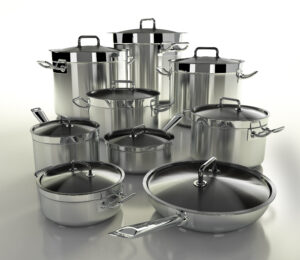
This image is property of images.pexels.com.
How is Calphalon different from other cookware brands?
Calphalon stands out from other cookware brands in several ways, including its innovative features, product variety, and commitment to quality. Here are some key factors that make Calphalon cookware unique:
Comparison of Calphalon to other popular cookware brands
- Innovative Technologies: Calphalon is renowned for its innovative technologies and materials, such as hard-anodized aluminum, that offer exceptional heat distribution, easy cleanup, and durability. The brand continually strives to develop new and efficient cooking solutions to meet the needs of home cooks.
- Wide Range of Cookware Options: Calphalon offers a comprehensive range of cookware options, including hard-anodized aluminum, stainless steel, non-stick, enameled cast iron, copper, and ceramic. This variety allows consumers to choose cookware that best suits their cooking style and preferences.
- Performance and Durability: Calphalon cookware is known for its outstanding performance and durability. The brand’s commitment to using high-quality materials and advanced construction techniques ensures that their products can withstand the rigors of everyday cooking and deliver exceptional results.
- Safety Features: Calphalon incorporates various safety features into its cookware to ensure user safety. From heat-resistant handles to tight-fitting lids, these features help minimize the risk of accidents and promote safe cooking.
- Brand Reputation: Calphalon has built a solid reputation for producing reliable and high-quality cookware. The brand is trusted by both professional chefs and home cooks and is often recommended for its performance, durability, and innovation.
- Customer Support: Calphalon provides excellent customer support, including warranty coverage and assistance with product-related inquiries or issues. This commitment to customer satisfaction sets Calphalon apart from other cookware brands.
Overall, Calphalon’s combination of innovative technologies, wide product range, performance, durability, safety features, and strong brand reputation make it a standout choice for those in search of high-quality cookware.
What materials are Calphalon pots and pans made from?
Calphalon offers cookware made from various materials, each with its unique properties and benefits. Let’s explore the different materials used in Calphalon cookware:
Explanation of the different materials used in Calphalon cookware
- Hard-Anodized Aluminum: Calphalon’s hard-anodized aluminum cookware is a signature material of the brand. It features a non-reactive, non-porous surface that resists scratching, staining, and corrosion. Hard-anodized aluminum provides excellent heat distribution and retention, allowing for even cooking and preventing hot spots.
- Stainless Steel: Calphalon’s stainless steel cookware is constructed with a heavy-gauge aluminum core surrounded by stainless steel. This combination offers superior heat conductivity and even cooking. Stainless steel is a durable and versatile material that can withstand high temperatures and is resistant to staining and corrosion.
- Non-Stick Coating: Many of Calphalon’s cookware lines feature a non-stick coating. This coating is typically made with multiple layers of PFOA-free materials, providing easy food release and effortless cleanup. Calphalon’s non-stick coatings are designed to be durable and long-lasting, even with everyday use.
- Enameled Cast Iron: Calphalon’s enameled cast iron cookware combines the excellent heat retention and even heating of cast iron with the durability and convenience of an enamel coating. This material is ideal for slow cooking, braising, and baking, as it distributes heat evenly and retains it over a long period.
- Copper: Calphalon’s copper cookware features a copper exterior for rapid and precise temperature control. The interior is typically lined with stainless steel for easy maintenance and durability. Copper provides excellent heat responsiveness, making it ideal for tasks that require precise temperature adjustment.
- Ceramic Coating: Calphalon’s ceramic-coated cookware features a non-stick ceramic coating that is free of PTFE and PFOA. This coating offers excellent food release and is scratch-resistant. Ceramic coatings are known for their non-toxic properties and health-conscious appeal.
Each material used in Calphalon cookware offers unique benefits and is suitable for different cooking methods and preferences. It’s important to choose the material that best aligns with your cooking style and needs.
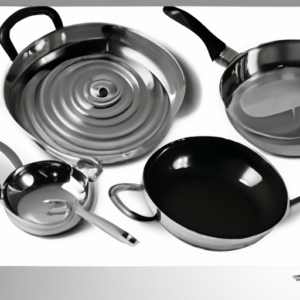
Is Calphalon non-stick?
Yes, Calphalon offers a range of non-stick cookware options that feature a durable non-stick coating.
Explanation of the non-stick properties of Calphalon cookware
Calphalon non-stick cookware is designed to provide easy food release and effortless cleanup. The non-stick coating prevents food from sticking to the surface, reducing the need for excessive oil or butter and making cooking and cleaning a breeze.
Calphalon’s non-stick coatings are typically made with multiple layers of high-quality materials, ensuring durability and longevity. These coatings are designed to be resistant to scratching and abrasion, allowing the cookware to maintain its non-stick properties over time.
It’s worth noting that Calphalon’s non-stick coatings are generally not designed for high-temperature cooking or for use with metal utensils, as excessive heat and sharp utensils can damage the coating. It’s important to follow the manufacturer’s instructions and use non-stick cookware within the recommended temperature range and with non-metal utensils to preserve the non-stick properties.
Overall, Calphalon non-stick cookware offers a convenient and low-fat cooking experience, allowing you to enjoy the benefits of non-stick performance without compromising on quality.
How do I clean Calphalon non-stick cookware?
Cleaning Calphalon non-stick cookware is simple and easy. Follow these step-by-step instructions for effective cleaning:
Step-by-step instructions for cleaning Calphalon non-stick cookware
- Allow the Cookware to Cool: After cooking, ensure the cookware has cooled down before cleaning to prevent burns and warping.
- Hand Washing is Recommended: While Calphalon non-stick cookware is dishwasher safe, hand washing is typically recommended to extend the life of the non-stick coating. Avoid using abrasive cleaning tools or harsh cleaners, as they can damage the non-stick surface.
- Use Warm, Soapy Water: Fill the sink with warm water and add a small amount of mild dish soap. Submerge the cookware and let it soak for a few minutes to loosen any food residues.
- Gentle Cleaning: Use a soft sponge or dishcloth to gently scrub the cookware, paying extra attention to areas with stuck-on food. Avoid using abrasive pads or brushes that can scratch the non-stick coating.
- Rinse Thoroughly: Rinse the cookware thoroughly under running water to remove any soapy residue. Make sure to remove all traces of soap to maintain the non-stick properties.
- Dry Thoroughly: After cleaning, dry the cookware completely with a soft towel or dishcloth. Ensuring the cookware is completely dry before storing helps prevent water spots or potential damage.
Following these cleaning steps will help keep your Calphalon non-stick cookware in excellent condition and extend its lifespan. By properly maintaining your cookware, you can enjoy its non-stick properties for years to come.
Recommendations for using the appropriate cleaning tools and products
When cleaning Calphalon non-stick cookware, it’s important to use gentle cleaning tools and products to avoid damaging the non-stick coating. Here are some recommendations:
- Soft Sponge or Dishcloth: Use a soft sponge or dishcloth to clean the cookware. Avoid abrasive pads, steel wool, or harsh brushes, as they can scratch the non-stick coating.
- Dish Soap: Choose a mild dish soap that is gentle and free of harsh chemicals. Avoid using cleaning products that contain bleach, ammonia, or citrus, as they can cause damage to the non-stick coating.
- Nylon or Silicone Utensils: When cooking with non-stick cookware, it’s best to use utensils made of nylon or silicone to prevent scratching the surface. Metal utensils can cause damage and reduce the lifespan of the non-stick coating.
By using appropriate cleaning tools and products, you can ensure that your Calphalon non-stick cookware stays in top condition and maintains its non-stick properties for longer.

Can I use metal utensils with Calphalon non-stick cookware?
While it’s generally recommended to use nylon, silicone, or wooden utensils with Calphalon non-stick cookware, there are certain types of Calphalon non-stick cookware that are compatible with metal utensils.
Discussion on the compatibility of metal utensils with Calphalon non-stick cookware
Calphalon offers specific lines of non-stick cookware that are designed to be compatible with metal utensils. These lines are typically labeled as “metal utensil safe” or “metal spatula safe” and feature a specially designed non-stick coating that is more resistant to scratching and abrasion.
However, most non-stick Calphalon cookware is not recommended for use with metal utensils. Metal utensils can scratch the non-stick coating, potentially compromising its non-stick properties and reducing the lifespan of the cookware.
To ensure the longevity of your non-stick Calphalon cookware, it’s best to use utensils made of nylon, silicone, or wood. These materials are gentle on the non-stick coating and are less likely to cause scratches or damage.
If you prefer using metal utensils or are unsure if your cookware is compatible, it’s best to refer to the specific product information or packaging to see if it is labeled as safe for use with metal utensils.
By using the right utensils, you can protect the non-stick coating and preserve the performance and durability of your Calphalon non-stick cookware.
Tips for preventing scratches and damage to the non-stick coating
To prevent scratches and damage to the non-stick coating of your Calphalon cookware, follow these tips:
- Use Nylon, Silicone, or Wooden Utensils: Opt for utensils made of nylon, silicone, or wood when cooking with non-stick Calphalon cookware. These materials are gentle on the coating and reduce the risk of scratches.
- Avoid Metal Utensils: Refrain from using metal utensils unless your specific Calphalon non-stick cookware is labeled as safe for use with metal utensils. Metal utensils can cause scratches and compromise the non-stick properties of the cookware.
- Avoid Cutting Food in the Pan: To prevent scratches, avoid cutting or slicing food directly in the non-stick cookware. Instead, use a separate cutting board or surface.
- Use Gentle Cleaning Tools: When cleaning non-stick cookware, use soft sponges or dishcloths to avoid scratching the coating. Avoid abrasive pads, steel wool, or harsh brushes.
- Store Properly: Stack your non-stick cookware carefully, with a layer of protective material between each piece to prevent scratches. Alternatively, hang your cookware or use a pot rack to store it.
Following these tips will help ensure that your Calphalon non-stick cookware remains in excellent condition and continues to perform well over time.
Are Calphalon pans oven-safe?
Yes, many Calphalon pans are oven-safe. However, the specific oven-safe temperature and
Explanation of the oven-safe capabilities of Calphalon pans
Calphalon offers a range of pans that are oven-safe, allowing you to transfer dishes from stovetop to oven without needing to switch cookware. Oven-safe pans offer greater versatility in cooking methods and allow for browning, braising, and finishing dishes in the oven.
The oven-safe temperature and duration will vary depending on the specific Calphalon pan and its construction. It’s important to check the product information or packaging of your Calphalon pan to determine its specific oven-safe temperature limits.
Most Calphalon pans can withstand oven temperatures up to 500°F (260°C), but it’s always best to refer to the specific product information for accurate temperature limits. Exceeding the recommended temperature can damage the pan and, in some cases, compromise the non-stick or other coating.
When using Calphalon pans in the oven, it’s essential to use caution and protect your hands with oven mitts or pot holders due to the high temperatures.
Overall, Calphalon pans provide the option to seamlessly transition from stovetop cooking to oven baking or broiling, allowing for greater culinary creativity and flexibility.
Recommended temperature limits for using Calphalon pans in the oven
While many Calphalon pans are oven-safe, it’s essential to follow the specific temperature limits provided by the manufacturer. Exceeding these limits can cause damage to the pan, including warping, loss of non-stick properties, or possibly even releasing harmful fumes.
Calphalon pans typically have oven-safe temperature limits of up to 500°F (260°C). However, specific products may have different temperature limits, so it’s crucial to refer to the product information or packaging for accurate information.
When cooking with Calphalon pans in the oven, it’s always best to preheat the pan along with the oven to ensure even cooking and to prevent sudden temperature changes that could potentially damage the pan or affect the quality of your dish.
To ensure both the longevity of your Calphalon pan and optimal cooking results, it’s crucial to follow the manufacturer’s recommendations and stay within the specified temperature limits.
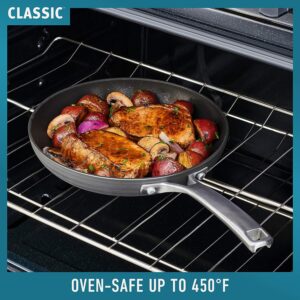
This image is property of images.pexels.com.
What is the recommended oven temperature for Calphalon cookware?
Calphalon recommends using its cookware within a specific range of temperatures to ensure optimal performance and longevity.
Guidelines for the safe and effective use of Calphalon cookware in the oven
The specific recommended oven temperature for Calphalon cookware will vary depending on the material and construction of the cookware. Here are some general guidelines to help you use Calphalon cookware safely and effectively in the oven:
- Hard-Anodized Aluminum Cookware: Calphalon’s hard-anodized aluminum cookware is typically safe to use in the oven at temperatures up to 500°F (260°C). Ensure you check the specific product information or packaging for accurate temperature limits.
- Stainless Steel Cookware: Calphalon’s stainless steel cookware is generally oven-safe up to temperatures of 500°F (260°C). However, some specific stainless steel pieces may have lower temperature limits, so check the manufacturer’s instructions for accurate information.
- Non-Stick Cookware: Non-stick Calphalon cookware is generally safe to use in the oven at temperatures up to 450°F (232°C). However, it’s crucial to refer to the specific product information or packaging for accurate temperature limits, as some non-stick coatings may have lower temperature thresholds.
- Enameled Cast Iron Cookware: Calphalon’s enameled cast iron cookware is typically oven-safe up to temperatures of 500°F (260°C). Check the product information or packaging for precise temperature limits, as individual products may differ.
- Copper Cookware: Calphalon’s copper cookware is generally safe to use in the oven at temperatures up to 450°F (232°C). It’s important to refer to the specific product information or packaging for accurate temperature limits.
Always refer to the specific product information and packaging for precise oven temperature recommendations for your Calphalon cookware. This will ensure that you are using the cookware within its safe temperature limits and guarantee optimal results.
Tips for adjusting cooking times and temperatures with Calphalon cookware
When using Calphalon cookware in the oven, it’s important to make slight adjustments to your usual cooking times and temperatures to achieve the best results. Here are some tips to help you adjust your cooking techniques when using Calphalon cookware:
- Preheat the Oven and the Cookware: Preheating the oven and the Calphalon cookware together helps ensure even heat distribution and consistent cooking results.
- Monitor Cooking Times: Due to the excellent heat conductivity of Calphalon cookware, you may need to slightly reduce your typical cooking times. Keep a close eye on your dish and check for doneness earlier than usual.
- Use Lower Heat Settings: Calphalon cookware has excellent heat retention, so you may need to reduce the oven temperature by about 25°F (14°C) compared to your usual cooking temperature. This helps avoid overcooking or burning your dish.
- Check for Doneness: Test your dish for doneness using the recommended methods, such as inserting a thermometer or performing visual checks. The specific doneness indicators will depend on the type of dish you’re preparing.
- Let the Cookware Rest: After removing your Calphalon cookware from the oven, allow it to cool slightly before handling. This resting period helps ensure safe and comfortable handling while also allowing the dish to settle and flavors to meld.
By making these minor adjustments to your cooking times and temperatures, you can achieve the best results when using Calphalon cookware in the oven.
Can I use Calphalon cookware on a smooth-top electric range?
Yes, Calphalon cookware is safe to use on a smooth-top electric range. Its flat, smooth bottom ensures proper contact and heat transfer on the cooking surface.
Explanation of the compatibility of Calphalon cookware with smooth-top electric ranges
Calphalon cookware is compatible with a wide range of stovetops, including smooth-top electric ranges. These ranges feature electric coils or heating elements beneath a smooth glass or ceramic surface.
When using Calphalon cookware on a smooth-top electric range, it’s important to follow the manufacturer’s instructions and take certain precautions:
- Use Flat-Bottomed Cookware: Calphalon cookware is designed with flat, smooth bottoms that ensure proper contact with the cooking surface. This allows for efficient heat transfer and even cooking. Avoid using cookware with warped or uneven bottoms, as they can lead to uneven cooking and potential damage to the range surface.
- Lift Cookware When Moving: To prevent scratching or damaging the smooth surface of the electric range, it’s best to lift the cookware instead of sliding it across the stovetop. Sliding heavy or abrasive cookware can cause scratches or scuff marks on the glass or ceramic surface.
- Adjust Heat Settings Carefully: Smooth-top electric ranges provide precise temperature control. Take care when adjusting the heat settings, as rapid changes may cause thermal stress on the stovetop surface. Gradually increase or decrease the heat to prevent potential damage.
- Keep Cookware Centered: Place the cookware on the heating element and ensure it is centered properly. This helps distribute heat evenly and prevents hot spots.
By following these guidelines and using Calphalon cookware correctly on a smooth-top electric range, you can enjoy safe and efficient cooking performance.
Benefits and considerations of using Calphalon on a smooth-top electric range
Using Calphalon cookware on a smooth-top electric range offers several benefits:
- Efficient Heat Transfer: Calphalon cookware is designed to provide even heat distribution, allowing for efficient cooking on smooth-top electric ranges. This ensures that your dishes cook evenly without hot spots.
- Versatile Cooking: Calphalon cookware is suitable for various cooking methods, including boiling, sautéing, frying, and simmering. The wide range of Calphalon cookware options allows you to prepare a wide array of dishes on your smooth-top electric range.
- Easy Cleanup: Calphalon cookware is generally easy to clean, making it convenient for everyday use on smooth-top electric ranges. Many Calphalon cookware lines feature non-stick coatings or non-porous surfaces, resulting in effortless food release and easy cleanup.
When using Calphalon cookware on a smooth-top electric range, it’s important to consider the following:
- Weight and Size: Calphalon cookware is typically constructed with quality materials that provide durability and superior heat retention. However, this can make some Calphalon pans heavier than other options. Consider the weight and size of the cookware when handling and transferring it to and from the smooth-top electric range.
- Compatibility: While Calphalon cookware is compatible with smooth-top electric ranges, it’s essential to ensure that the cookware’s size and diameter match the heating element’s size. For optimal heat transfer and cooking performance, choose cookware that has a diameter similar to the heating element.
By keeping these considerations in mind, you can enjoy the benefits of using Calphalon cookware while enjoying safe and efficient cooking on your smooth-top electric range.
Happy Cooking,

Lin, Blogger and Grandmother of 10

